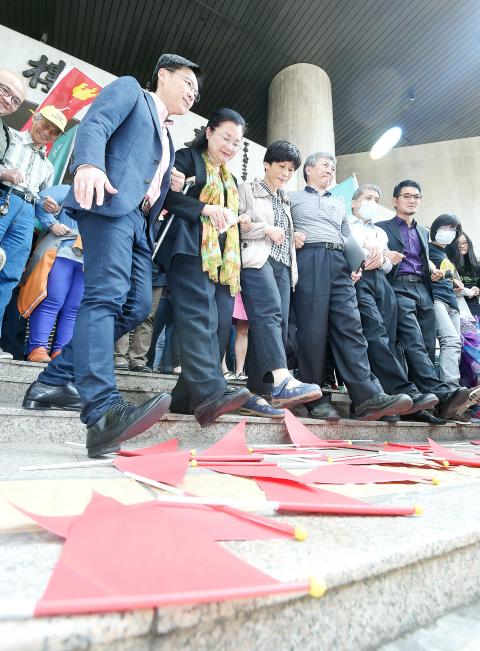Representatives from several environmental groups protested outside the Legislative Yuan yesterday morning, urging the government to set stricter regulations to prevent further deterioration of the air quality in southern Taiwan.
Protesters said that they were enraged by a statement made by Premier Mao Chi-kuo (毛治國), who said that people cannot find high-tech jobs in southern Taiwan.
The protesters said that what Mao will not find in southern Taiwan is clean air, which they need for a healthy life.

Photo: Fang Pin-chao, Taipei Times
They asked how people in the south are able to find jobs without being in good health.
Regulations say that schools are obliged to fly a red flag when the pollution standard index reaches 100 or PM2.5 levels exceed 36 micrograms (mcg) per cubic meter. The flag means that people with certain health issues should avoid outdoor activities and be aware of changes in their health.
PM2.5 is an indicator of airborne particles measuring 2.5 micrometers or less.
Citizen of the Earth Foundation Taipei office director Antonio Chou (周東漢) said that an experiment had been conducted in an elementary school in Kaohsiung’s Zuoying District (左營) from November last year to last month that showed a red flag was raised on 64 of the 85 school days during the period.
Chou said the findings showed that people in southern Taiwan should not engage in outdoor activities 75 percent of the time.
Foundation deputy executive director Wang Min-ling (王敏玲) said that she is used to wearing a face mask all year round having lived in the Kaohsiung-Pingtung County area for many years.
Wang said that the air is dense with particulate matter from autumn to spring, adding that the air quality changes for the better in summer, but ozone issues arise when the weather is hot.
The average ozone density in Kaohsiung’s Linyuan District (林園) in October last year was 58.5 parts per billion (ppb), which was higher than the government standard of 30ppb, she said.
She asked why 3.61 million residents in Kaohsiung and Pingtung County should continue putting up with contaminated air.
The PM2.5 standard set by the Environmental Protection Administration (EPA) for safe values is between 35mcg and 53mcg per cubic meter, she said, but the WHO has a 25mcg per cubic meter standard.
Using the WHO’s standard, children could never play outside, she said.
“A study showed that the risks of not exercising are similar to those associated with high blood pressure, Wang said. How can people in the south go outside and exercise in these circumstances?”
Taiwan Healthy Air Alliance founder Yeh Guang-peng (葉光芃) said that Puli Township (埔里) in Nantou County as well as Mailiao Township (麥寮) in Yunlin County have the poorest air quality in Taiwan.
While Puli residents are set to march on Saturday [tomorrow], the central government is still sleeping, Yeh said.
Chen Hsien-heng (陳咸亨), director-general of the EPA’s Department of Air Quality Protection and Noise Control, said that the administration is considering raising its standards for air quality.
However, its focus is on regulating pollutants at their source, Chen said.
Chen said that the move by six cities and counties in southern Taiwan to ban the burning of coke and coal was admirable, but a similar move nationwide would require further consideration.

Taiwan is to commence mass production of the Tien Kung (天弓, “Sky Bow”) III, IV and V missiles by the second quarter of this year if the legislature approves the government’s NT$1.25 trillion (US$39.78 billion) special defense budget, an official said yesterday. Commenting on condition of anonymity, a defense official with knowledge of the matter said that the advanced systems are expected to provide crucial capabilities against ballistic and cruise missiles for the proposed “T-Dome,” an advanced, multi-layered air defense network. The Tien Kung III is an air defense missile with a maximum interception altitude of 35km. The Tien Kung IV and V

The disruption of 941 flights in and out of Taiwan due to China’s large-scale military exercises was no accident, but rather the result of a “quasi-blockade” used to simulate creating the air and sea routes needed for an amphibious landing, a military expert said. The disruptions occurred on Tuesday and lasted about 10 hours as China conducted live-fire drills in the Taiwan Strait. The Civil Aviation Administration (CAA) said the exercises affected 857 international flights and 84 domestic flights, affecting more than 100,000 travelers. Su Tzu-yun (蘇紫雲), a research fellow at the government-sponsored Institute for National Defense and Security Research, said the air

Taiwan lacks effective and cost-efficient armaments to intercept rockets, making the planned “T-Dome” interception system necessary, two experts said on Tuesday. The concerns were raised after China’s military fired two waves of rockets during live-fire drills around Taiwan on Tuesday, part of two-day exercises code-named “Justice Mission 2025.” The first wave involved 17 rockets launched at 9am from Pingtan in China’s Fujian Province, according to Lieutenant General Hsieh Jih-sheng (謝日升) of the Office of the Deputy Chief of the General Staff for Intelligence at the Ministry of National Defense. Those rockets landed 70 nautical miles (129.6km) northeast of Keelung without flying over Taiwan,

A strong continental cold air mass is to bring pollutants to Taiwan from tomorrow, the Ministry of Environment said today, as it issued an “orange” air quality alert for most of the country. All of Taiwan except for Hualien and Taitung counties is to be under an “orange” air quality alert tomorrow, indicating air quality that is unhealthy for sensitive groups. In China, areas from Shandong to Shanghai have been enveloped in haze since Saturday, the ministry said in a news release. Yesterday, hourly concentrations of PM2.5 in these areas ranged from 65 to 160 micrograms per cubic meter (mg/m³), and pollutants were